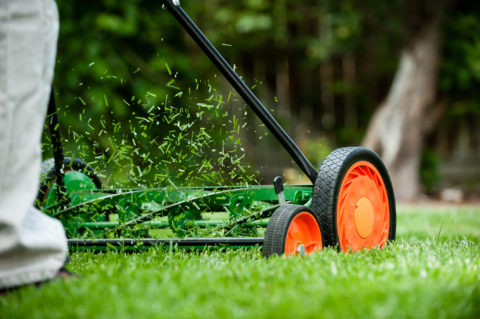
Follow these mowing tips for less work and a healthier lawn.
It’s spring weather, and people are starting to mow their lawns. Here are some mowing tips to help keep your lawn green and healthy this season.
Grow your lawn longer.
2.5 to 3 inches is the ideal mowing height for most grass types. In early spring we recommend the first cut at 1.5 to 2 inches. This helps remove dead blades and other debris. Then raise the blade to the regular setting.
3 inches is the perfect height. This will develop and maintain a strong, robust and healthy lawn. Longer grass blades will shade the roots. The lawn will need less water, and it will develop and maintain a deep, healthy root system and excellent color.
2 inches is a bit too short. Color and growth will be average to poor. Setting mower up to 2.5 to 3-inch cutting height will improve the strength and color of your turf.
1 inch is too low. The root system will disintegrate and lawn will become susceptible to disease, drought, heat, cold and stress. Raise the mower height!
Use a 2/3 mowing system.
The best mowing results come from a 2/3 system. Never let your grass grow more than 1/3 longer than your desired height. When your grass reaches that height, you cut the top 1/3 away. For example, if you want your grass to be 2.5 to 3 inches tall, you mow away the top 1 to 1.5 inches each time your grass reaches 4 inches tall.
According to Kansas State University, “Removing more than one-third of the grass blades may cause root growth to cease while the leaves and shoots are regrowing. This practice can be especially destructive if practiced continuously over a period of successive mowings. Roots may not have a chance to fully develop and the plants will thus be more susceptible to environmental and management stresses.”
Mulch mow!
Leave clippings on the lawn. Mulch mowing adds organic matter to the soil. As the grass blades break down, they add nitrogen, reducing the amount of fertilizer you need to apply. Mulch mowing can reduce your total mowing, bagging, and disposal time by up to 40 percent. No more bagging and dragging clippings to the curb!
Mulch mowing does not contribute to thatch when mowed properly. Do not mow tall grass too short, which results in long clippings. Long clippings may contribute to thatch because they break down more slowly. Using the 2/3 mowing system will prevent thatch buildup. If the grass is very overgrown, mow twice: first at a high setting, then wait a few days and mow lower.
You can mulch mow with any mower. If you are in the market for a new mower, consider buying a mulching mower. Mulching mowers have special blades that cut the grass, then cut the clippings over and over again until they’re very small. They almost disappear into the lawn. Here are some mulching mower buying tips from Seattle Public Utilities.
In the spring, you may want to mow every 4 to 5 days instead of every 7 days. (You may be able to reduce frequency in summer.)
Mow grass when it’s dry.
Try to avoid mowing wet grass. Dry grass cuts more easily. According to Penn State Extension, “Timing tests show that mowing dry grass requires less time than mowing wet grass.”
Wet grass may ball up and clog the mower, especially if you are using a mulching mower. It may also form clumpy masses on the lawn surface. Mowing dry grass gives a finer appearing lawn.
Maintain a sharp mower blade.
Dull blades tear turf. This leaves a ragged appearance. Ragged leaf edges also increase the potential for turf diseases. Ragged edges also lose more water and may develop brown tips. Cleanly cut turf looks better and is often healthier than turf with torn leaves. Sharpen mower blades twice a year.
Here is a video from This Old House about how to sharpen mower blades. Or take the mower to a lawn mower store for expert service.
Following these mowing tips will help you have a healthier lawn this growing season.
Contact us about our lawn health care program.
While mowing properly will improve your lawn’s health, other steps are also important. Our natural lawn care services focus on building the health of your soil and lawn.
We offer fertilization, aeration and overseeding, lime, corn gluten, weed management and more. We monitor your lawn and soil health and adjust treatments as necessary. Contact us for more information.
